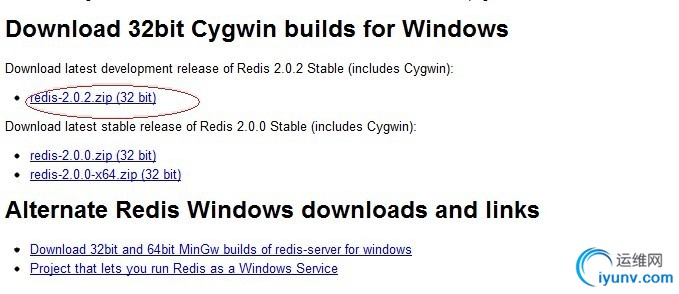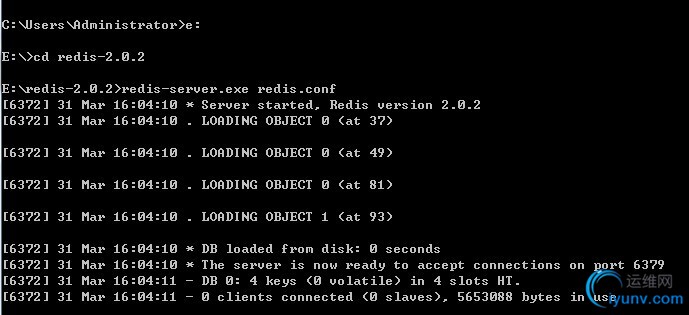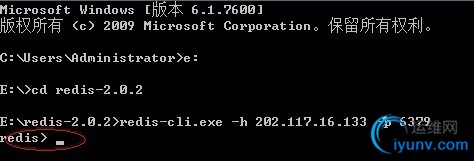|
|
window平台Redis安装
redis windows安装文件下载地址:http://code.google.com/p/servicestack/wiki/RedisWindowsDownload#Download_32bit_Cygwin_builds_for_Windows
我选择的redis为最新版的安装文件,见下图:

Redis安装文件解压后,有以下几个文件。见下图

redis-server.exe:服务程序
redis-check-dump.exe:本地数据库检查
redis-check-aof.exe:更新日志检查
redis-benchmark.exe:性能测试,用以模拟同时由N个客户端发送M个 SETs/GETs 查询 (类似于 Apache 的ab 工具).
在解压好redis的安装文件到E:\根目录后,还需要在redis根目录增加一个redis的配置文件redis.conf,文件具体内容附件中有,不过这里我仍然把配置文件的内容贴上来:
配置文件
[html] view plaincopy
- # Redis configuration file example
-
- # By default Redis does not run as a daemon. Use 'yes' if you need it.
- # Note that Redis will write a pid file in /var/run/redis.pid when daemonized.
- daemonize no
-
- # When run as a daemon, Redis write a pid file in /var/run/redis.pid by default.
- # You can specify a custom pid file location here.
- pidfile /var/run/redis.pid
-
- # Accept connections on the specified port, default is 6379
- port 6379
-
- # If you want you can bind a single interface, if the bind option is not
- # specified all the interfaces will listen for connections.
- #
- # bind 127.0.0.1
-
- # Close the connection after a client is idle for N seconds (0 to disable)
- timeout 300
-
- # Set server verbosity to 'debug'
- # it can be one of:
- # debug (a lot of information, useful for development/testing)
- # notice (moderately verbose, what you want in production probably)
- # warning (only very important / critical messages are logged)
- loglevel debug
-
- # Specify the log file name. Also 'stdout' can be used to force
- # the demon to log on the standard output. Note that if you use standard
- # output for logging but daemonize, logs will be sent to /dev/null
- logfile stdout
-
- # Set the number of databases. The default database is DB 0, you can select
- # a different one on a per-connection basis using SELECT where
- # dbid is a number between 0 and 'databases'-1
- databases 16
-
- ################################ SNAPSHOTTING #################################
- #
- # Save the DB on disk:
- #
- # save
- #
- # Will save the DB if both the given number of seconds and the given
- # number of write operations against the DB occurred.
- #
- # In the example below the behaviour will be to save:
- # after 900 sec (15 min) if at least 1 key changed
- # after 300 sec (5 min) if at least 10 keys changed
- # after 60 sec if at least 10000 keys changed
- save 900 1
- save 300 10
- save 60 10000
-
- # Compress string objects using LZF when dump .rdb databases?
- # For default that's set to 'yes' as it's almost always a win.
- # If you want to save some CPU in the saving child set it to 'no' but
- # the dataset will likely be bigger if you have compressible values or keys.
- rdbcompression yes
-
- # The filename where to dump the DB
- dbfilename dump.rdb
-
- # For default save/load DB in/from the working directory
- # Note that you must specify a directory not a file name.
- dir ./
-
- ################################# REPLICATION #################################
-
- # Master-Slave replication. Use slaveof to make a Redis instance a copy of
- # another Redis server. Note that the configuration is local to the slave
- # so for example it is possible to configure the slave to save the DB with a
- # different interval, or to listen to another port, and so on.
- #
- # slaveof
-
- # If the master is password protected (using the "requirepass" configuration
- # directive below) it is possible to tell the slave to authenticate before
- # starting the replication synchronization process, otherwise the master will
- # refuse the slave request.
- #
- # masterauth
-
- ################################## SECURITY ###################################
-
- # Require clients to issue AUTH before processing any other
- # commands. This might be useful in environments in which you do not trust
- # others with access to the host running redis-server.
- #
- # This should stay commented out for backward compatibility and because most
- # people do not need auth (e.g. they run their own servers).
- #
- # requirepass foobared
-
- ################################### LIMITS ####################################
-
- # Set the max number of connected clients at the same time. By default there
- # is no limit, and it's up to the number of file descriptors the Redis process
- # is able to open. The special value '0' means no limts.
- # Once the limit is reached Redis will close all the new connections sending
- # an error 'max number of clients reached'.
- #
- # maxclients 128
-
- # Don't use more memory than the specified amount of bytes.
- # maxmemory
-
- appendonly no
- appendfsync always
- glueoutputbuf yes
将附件中的redis_conf.rar解压下来放到redis的根目录中即可。到此,redis的安装已经完毕。下面开始使用redis数据库。
启动redis:
输入命令:redis-server.exe redis.conf
启动后如下图所示:

启动cmd窗口要一直开着,关闭后则Redis服务关闭。
这时服务开启着,另外开一个窗口进行,设置客户端:
输入命令:redis-cli.exe -h 202.117.16.133 -p 6379
输入后如下图所示:

上面的IP写自己的哦:
php扩展Redis功能
1 首先,查看所用php编译版本V6/V9 在phpinfo()中查看

2 下载扩展 地址:https://github.com/nicolasff/phpredis/downloads(注意所支持的php版本)
3 将下载的php_redis.dll放在php扩展目录中(ext),并修改配置文件php.ini
添加 扩展的时候一定要
extension=php_igbinary.dll
extension=php_redis.dll
这个顺序
否则重启Apache的时候会出现,PHP startup 错误
4 重新启动服务,查看phpinfo(),下面表示成功;

5 用PHP测试
Php代码
[php] view plaincopy
- $redis = new Redis();
- $redis->connect("192.168.138.2","6379"); //php客户端设置的ip及端口
- //存储一个 值
- $redis->set("say","Hello World");
- echo $redis->get("say"); //应输出Hello World
-
- //存储多个值
- $array = array('first_key'=>'first_val',
- 'second_key'=>'second_val',
- 'third_key'=>'third_val');
- $array_get = array('first_key','second_key','third_key');
- $redis->mset($array);
- var_dump($redis->mget($array_get));
|
|
|